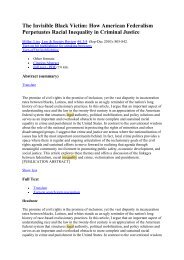Consumer Online Shopping Attitudes and Behavior: An ... - E-Journal
Consumer Online Shopping Attitudes and Behavior: An ... - E-Journal
Consumer Online Shopping Attitudes and Behavior: An ... - E-Journal
You also want an ePaper? Increase the reach of your titles
YUMPU automatically turns print PDFs into web optimized ePapers that Google loves.
Electronic Commerce Customer Relationship Management<br />
quality/performance/product uncertainty, (3) product availability, (4) price, (5) social presence requirement, (6) product presence<br />
requirement, (7) dependability of product, (8) possibility of customized products, <strong>and</strong> (9) br<strong>and</strong> (Jahng et al. 2001; Liang <strong>and</strong><br />
Huang 1998; Kim et al. 2001; Cho et al. 2001; Lowengart <strong>and</strong> Tractinskky 2001; Muthitacharoen 1999).<br />
In addition, researchers examine different aspects of service provided by the venders through the online shopping process. Service<br />
factors related to online shopping attitudes <strong>and</strong> behavior include (1) customer communication channels/ease of vendor contact,<br />
(2) response to customer needs, (3) accessibility of sales people, (4) reliability of the purchasing process/process uncertainty, (5)<br />
timeliness of orders or services/waiting time, (6) availability of personalized services, (7) ease of return <strong>and</strong> refunds, (8) fraud,<br />
(9) delivery (speed, tracking <strong>and</strong> tracing), (10) transaction costs, (11) peripheral costs, <strong>and</strong> (12) promotion (Ho <strong>and</strong> Wu 1999;<br />
Liang <strong>and</strong> Huang 1998; Lohse <strong>and</strong> Spiller 1998; Liang <strong>and</strong> Lai, 2000; Bhatnagar et al. 2000; Kim et al. 2001; Cho et al. 2001;<br />
Li et al. 2001; Muthitacharoen 1999).<br />
Website Quality<br />
Twenty studies investigate the relationship between website quality <strong>and</strong> consumers online shopping attitudes <strong>and</strong> behavior from<br />
different points of view. For example, Gefen <strong>and</strong> Straub (2000) investigate the impact of perceived ease of use (PEOU) <strong>and</strong><br />
perceived usefulness (PU) on e-commerce adoption using 202 MBA students as subjects. They report that while PU affects<br />
intended use when a Web site is used for a purchasing task, PEOU only has an indirect influence on online shopping behavior<br />
by directly influencing PU. Lee et al. (2001) obtain the similar findings in their recent study of design factors affecting consumer<br />
loyalty. In one study, Song <strong>and</strong> Zahedi (2001) classify website quality elements into five categories according to their purpose:<br />
for promotion, service, informational influence, self-efficacy, <strong>and</strong> resources facilitation. These investigators find that each of the<br />
five significantly <strong>and</strong> positively reinforces the consumers’ perceptions in these factors, which in turn positively influence<br />
consumer online shopping attitudes <strong>and</strong> behavior.<br />
Zhang, von Dran, Small, <strong>and</strong> Barcellos (1999, 2000), <strong>and</strong> Zhang <strong>and</strong> von Dran (2000) make an attempt to evaluate website quality<br />
from user satisfaction <strong>and</strong> dissatisfaction perspective. Their studies show that website design features can be regarded as hygiene<br />
<strong>and</strong> motivator factors that contribute to user dissatisfaction <strong>and</strong> satisfaction with a website. Hygiene factors are those whose<br />
present make a website functional <strong>and</strong> serviceable, <strong>and</strong> whose absence causes user dissatisfaction. Some of the categories of<br />
hygiene factors are: Privacy <strong>and</strong> Security, Technical Aspect, Navigation, Impartiality, <strong>and</strong> Information Content. Motivator factors<br />
are those that add value to the website by contributing to user satisfaction. Five categories of motivation factors are: Enjoyment,<br />
Cognitive Outcome, User Empowerment, Credibility, Visual Appearance, <strong>and</strong> Organization of Information Content. In their<br />
continued effort, they further discover that the most important website quality factors ranked by e-commerce consumers are<br />
hygiene factors (von Dran <strong>and</strong> Zhang 1999; Zhang et al. 2000; Zhang <strong>and</strong> von Dran 2001a, 2001b; Zhang et al. 2001). Liang <strong>and</strong><br />
Lai (2000) review website quality factors influencing Internet buying behavior by categorizing them into three groups, two of them<br />
are also named motivators <strong>and</strong> hygiene factors, <strong>and</strong> third media richness factors. In their opinion, motivators are those who support<br />
the transaction process directly while hygiene factors protect the consumers from risks or unexpected events in the transaction<br />
process. Media richness factors “add more information channels or richness in information presentation” (Liang <strong>and</strong> Lai 2000,<br />
p. 2). They suggest that providing good transaction support will help Internet venders to beat their electronic competitors, while<br />
the hygiene factors need to be paid attention if they want to attract consumers from traditional stores.<br />
Overall, the measures employed to value website quality by the researchers include the websites’ information content, information<br />
presentation, interaction between customers <strong>and</strong> venders, navigation, searching mechanism, security, site technical feature, media<br />
richness, <strong>and</strong> so forth (Zhang <strong>and</strong> von Dran 2000, 2001a, 2001b; Gr<strong>and</strong>on <strong>and</strong> Ranganathan 2001; Cho et al. 2001; Kim et al.<br />
2001; Lohse <strong>and</strong> Spiller 1998; Koufaris et al. 2002; Ho <strong>and</strong> Wu 1999).<br />
In summary, a variety of factors related to website quality have been demonstrated to significantly influence consumers’ online<br />
shopping attitudes <strong>and</strong> behavior. Better website quality can guide the consumers complete transactions smoothly <strong>and</strong> attract them<br />
to revisit this Internet store. In contrast, worse quality would hinder their online shopping moves.<br />
<strong>Attitudes</strong> Towards <strong>Online</strong> <strong>Shopping</strong><br />
<strong>Consumer</strong>s’ attitudes toward online shopping have gained a great deal of attention in the empirical literature, with 22 out of 35<br />
papers focusing on it. Consistent with the literature <strong>and</strong> models of attitude change <strong>and</strong> behavior (e.g., Fishbein <strong>and</strong> Ajzen 1975),<br />
it is believed that consumer attitudes will affect intention to shop online <strong>and</strong> eventually whether a transaction is made. This is a<br />
512 2002 — Eighth Americas Conference on Information Systems














